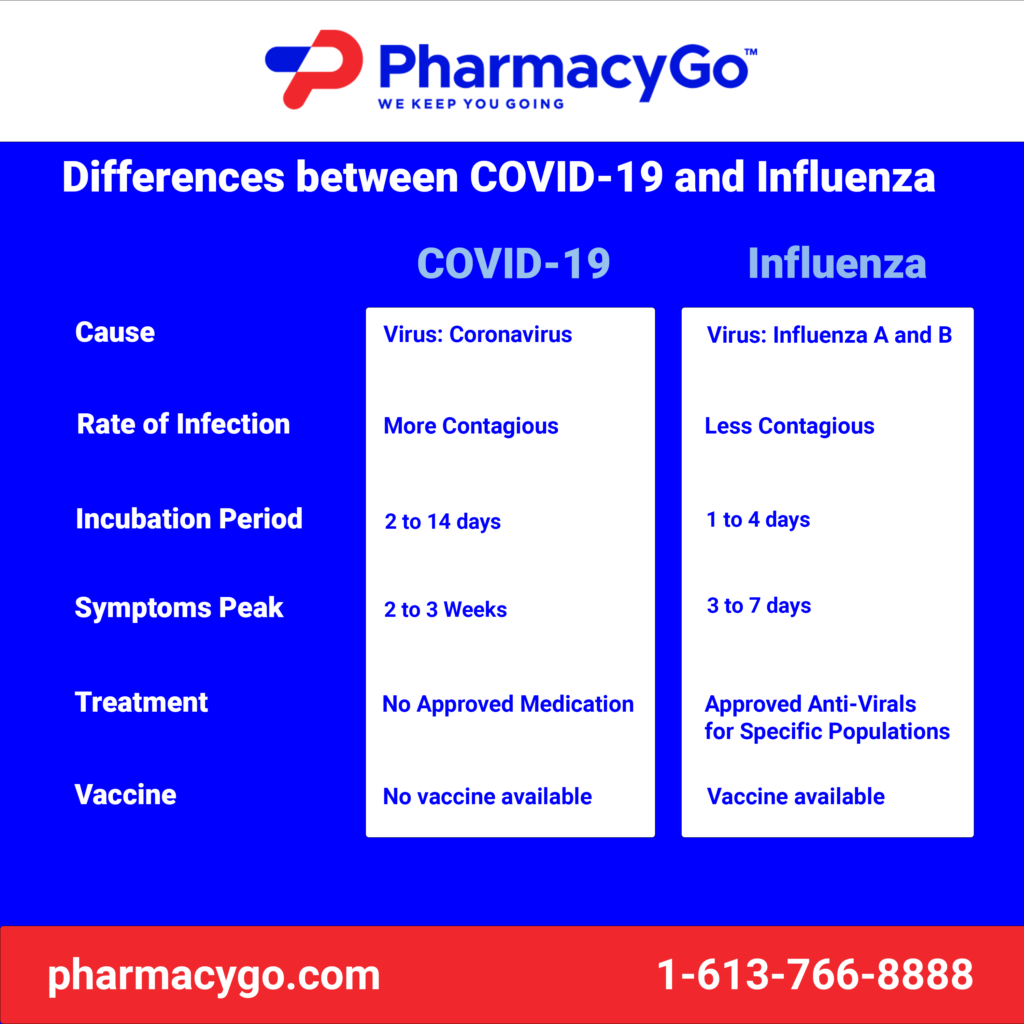Coronavirus disease (COVID-19) is a newly discovered coronavirus that is currently resulting in millions of people around the world becoming ill. It is a contagious respiratory disease, primarily affecting the lungs and the throat and is responsible for at least 820k deaths globally to date – with new cases rising daily.
If a person becomes infected with COVID-19 their symptoms can range from mild to severe or they might not experience the necessary symptoms at all (asymptomatic).
COVID-19 might be mistaken for Influenza (Flu) because they both have many characteristics in common. However, evidence has shown that COVID-19 causes more severe disease than the seasonal influenza. While many people have built up immunity to seasonal flu strains, COVID-19 is a new virus to which no one has immunity. That means more people are susceptible to infection, and some will suffer severe disease.
To help you distinguish between the two viruses, we’ve outlined the key differences and similarities in this article.
Causes:
COVID-19 is short for ‘Coronavirus Disease 2019’. It originated from the coronavirus family which is linked to diseases such as Severe Acute Respiratory Syndrome (SARS) and Middle East Respiratory Syndrome (MERS-COV)
Influenza on the other hand, is caused by Influenza A and B strands of viruses.
So how can you tell them apart? Here’s a summary.

Symptoms:
One of the reasons that people often mistake COVID-19 for the Flu is because they cause similar symptoms in infected people. Some of these symptoms include:
- Sore Throat
- Fever
- Chills
- Headache
- Muscle Soreness
- Fatigue
- Cough
- Runny Nose or Congestion
Method of Transmission:
Transmission refers to how the virus spreads from person to person. Both COVID-19 and the Flu can be spread via. respiratory droplets. It is transmitted more easily when persons who have become infected are within 6 feet of each other. This is because the droplets can land in the mouth, nose, or be inhaled into the lungs.
Coughing, sneezing, and talking are the most common ways these infections are known to spread. However, both viruses can remain on surfaces for hours. It is possible to spread if an individual touches a surface that contains the virus and touches their face afterward.
Complications:
As far as evidence shows to date, children are more likely to become infected with influenza than COVID-19. They are known to be one of the main contributors to influenza outbreaks.
Both Influenza and Covid-19 affect individuals with pre-existing health conditions, older age groups (65 and up), pregnant women, and people with weakened immune systems. These individuals are the most at risk for developing severe and fatal symptoms if they become infected.
How long symptoms appear after infection:
Influenza: If an individual is infected with Influenza, it may take between 1 to 4 days (Avg. of 2 days) for symptoms to appear.
COVID-19: If an individual is infected with COVID-19 it can take 2 – 14 days (Avg. of 5 days) for symptoms to appear.
Peak of Symptoms:
Influenza: The severity of Influenza symptoms often peak 3-7 days after a person has become infected.
COVID-19: The severity of COVID-19 symptoms can take up to 2 or 3 weeks.
Rate of Infection:
COVID-19 is more contagious than Influenza. This is determined by the R0 number of each virus. The R0 number or reproduction number is a value that measures how many people a single individual with the virus can infect.
The R0 number for Influenza is 1.3 while the R0 number for COVID-19 is between 2- 2.5.
Treatment:
Influenza: While there are antiviral medications on the market to help combat the flu, they are only recommended in special high-risk populations. The best treatment is self-isolation and supportive care. This includes staying well hydrated and using over-the-counter products such as Acetaminophen in the event that the flu causes high-fevers or aches.
COVID-19: Research is still being conducted to find a treatment that can help to reduce the symptoms of COVID-19 in patients.
Prevention:
COVID-19 and Influenza require virtually the same measures to prevent the spread of the virus:
- Staying home if you’re sick and limiting your contact with people.
- Washing your hands regularly, and using hand sanitizer when hand washing stations are not available.
- Continuing to wear a face mask when in public spaces.
- Maintaining social distancing i.e. standing 6 feet apart from people when in public.
- Coughing and sneezing into your flexed elbow.
- Telling your healthcare provider about your symptoms and travel history.
Vaccination:
An approved vaccine exists for Influenza. However, researchers are still learning more about COVID-19 and have not released a vaccine for it at the time this article was written.
Subscribe to our newsletter to keep receiving helpful news and tips like this one.

